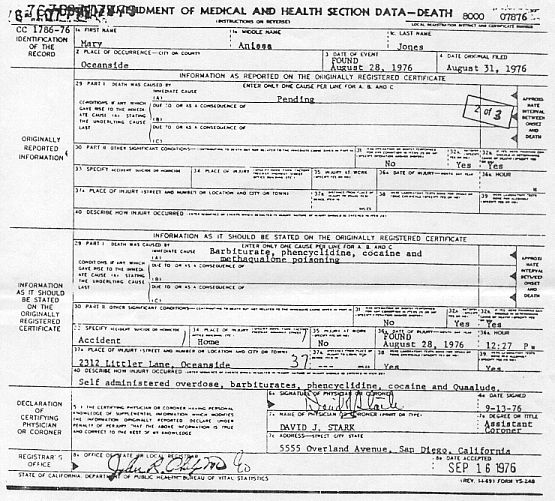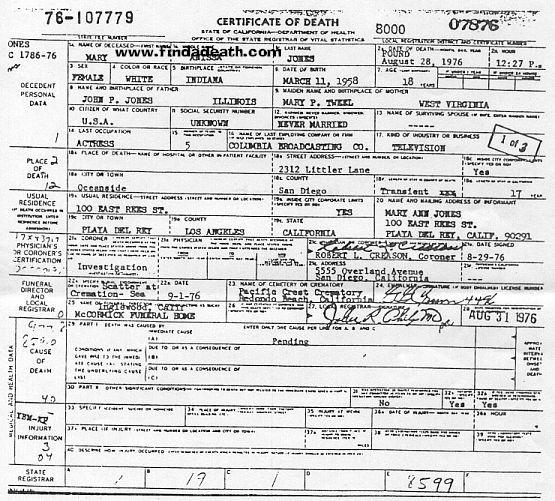Anissa Jones Death: Unveiling The Truth Behind The Tragic Loss
When it comes to celebrity news, sometimes the stories we hear leave us heartbroken. The Anissa Jones death shook the world of entertainment, leaving fans in disbelief. Many remember her as the adorable Patty Duke look-alike who captivated audiences in the 70s. But what really happened? In this article, we’ll dive deep into the life and untimely passing of Anissa Jones, uncovering the truth behind the headlines.
Before we jump into the details, it’s important to understand why Anissa Jones matters. Her career, though brief, left a lasting impression on millions of viewers. Her talent shone brightly, even at such a young age. But like many child stars, her life took unexpected turns. Today, we aim to shed light on her journey, her struggles, and ultimately, her tragic death.
This isn’t just about sensationalism; it’s about honoring her legacy and understanding the challenges faced by young performers in Hollywood. So, buckle up as we take a trip down memory lane to explore the highs and lows of Anissa Jones’ life.
Read also:Curious Carly Real Name And Age The Story Behind The Viral Sensation
Biography: Who Was Anissa Jones?
Before we delve into the specifics of Anissa Jones death, let’s take a moment to remember who she was. Born on January 5, 1958, in Los Angeles, California, Anissa Jones was destined for the spotlight. From a young age, she demonstrated a natural flair for acting, capturing the hearts of audiences with her charm and talent.
Here’s a quick glance at her life through a biographical lens:
| Full Name | Anissa Jones |
|---|---|
| Born | January 5, 1958, Los Angeles, California |
| Known For | Role as Buffy in "Family Affair" |
| Death | June 3, 1976 |
| Cause of Death | Drug Overdose |
Anissa’s early life was filled with promise, but as we’ll explore, her journey wasn’t without its challenges.
Early Life and Career
Growing up in Hollywood, Anissa Jones had the world at her feet. By the age of six, she landed her first major role as Buffy in the classic TV series "Family Affair." The show aired from 1966 to 1971 and became a cultural phenomenon, introducing millions to the lovable character of Buffy.
During this time, Anissa worked alongside seasoned actors like Brian Keith and Sebastian Cabot. Her performance earned critical acclaim, and she quickly became a household name. But fame at such a young age came with its own set of pressures.
Let’s break it down:
Read also:Unlocking The Power Of Remoteiot Platform Ssh A Raspberry Pi Download Revolution
- Anissa began acting at the tender age of six.
- Her role in "Family Affair" brought her international recognition.
- Despite her success, she faced the challenges of growing up in the public eye.
The Downward Spiral: Challenges Faced by Child Stars
As much as we admire child stars, it’s crucial to acknowledge the struggles they endure. For Anissa Jones, the pressures of fame took a toll on her mental and emotional well-being. By the time "Family Affair" ended, Anissa found herself grappling with identity issues and the harsh realities of adult life.
Many child stars face similar challenges:
- Lack of privacy and constant media scrutiny.
- Difficulty transitioning from child roles to adult roles.
- Financial mismanagement and exploitation by handlers.
Anissa’s story serves as a reminder of the importance of supporting young performers and ensuring they have the tools to navigate the complexities of the entertainment industry.
Anissa Jones Death: The Tragic End
On June 3, 1976, the world lost Anissa Jones at the young age of 18. Her death was ruled a drug overdose, a heartbreaking conclusion to a life filled with potential. The news sent shockwaves through the entertainment community and left fans reeling.
But what led to this tragic event? Reports suggest that Anissa struggled with substance abuse during her teenage years. Like many others, she may have turned to drugs as a way to cope with the pressures of fame and personal challenges.
Here’s a breakdown of the events:
- Anissa was found unresponsive in her Hollywood apartment.
- Authorities confirmed the cause of death as a drug overdose.
- Her passing sparked a conversation about the dangers of drug addiction in the entertainment industry.
Legacy and Impact
Even though Anissa Jones’ life was cut short, her legacy endures. Fans fondly remember her as the bright and bubbly Buffy from "Family Affair." Her performances continue to delight new generations, ensuring that her talent is never forgotten.
Moreover, her story highlights the importance of mental health awareness and support systems for young performers. It serves as a cautionary tale about the perils of fame and the need for better safeguards in the entertainment industry.
Lessons Learned: What Can We Take Away?
Anissa Jones’ journey teaches us valuable lessons about the challenges faced by child stars. Here are a few key takeaways:
- Child actors need robust support systems to help them navigate the pressures of fame.
- Mental health should be a priority, both during and after their careers.
- The entertainment industry must do more to protect its youngest talents.
By learning from Anissa’s story, we can work towards creating a safer and more supportive environment for future generations of performers.
Family Affair: A Look Back at the Show
For many, "Family Affair" was more than just a TV show; it was a glimpse into the lives of a quirky yet loving family. Anissa Jones’ character, Buffy, added charm and humor to every episode. The show tackled various themes, from sibling rivalry to the challenges of growing up, resonating with audiences of all ages.
Here’s why "Family Affair" remains relevant:
- Its relatable storylines continue to captivate viewers.
- Anissa’s performance as Buffy left a lasting impression.
- The show’s legacy lives on through reruns and streaming platforms.
Remembering Anissa: Tributes and Memorials
Over the years, fans and fellow performers have paid tribute to Anissa Jones in various ways. From online memorials to fan clubs, her memory continues to be celebrated. These tributes not only honor her legacy but also keep her story alive for future generations.
Some notable tributes include:
- Fan websites dedicated to her life and career.
- Documentaries exploring the lives of child stars in Hollywood.
- Charitable efforts in support of mental health and addiction awareness.
The Role of Media: Sensationalism vs. Sensitivity
When it comes to reporting on celebrity deaths, the media often walks a fine line between sensationalism and sensitivity. In the case of Anissa Jones death, the coverage sparked debates about how such stories should be handled.
Here’s what we can learn:
- Respectful reporting is essential when covering sensitive topics.
- Media outlets should prioritize accuracy and empathy in their coverage.
- Public discourse can help shape better practices in journalism.
Support Systems for Child Stars: What’s Being Done Today?
In light of stories like Anissa Jones’, the entertainment industry has taken steps to improve support systems for child stars. From mental health resources to financial protection, these measures aim to safeguard young performers and ensure their well-being.
Here are some initiatives:
- Mandatory education and counseling for child actors.
- Legal protections to prevent exploitation and mismanagement of finances.
- Industry-wide initiatives promoting mental health awareness.
Conclusion: Honoring Anissa’s Legacy
In conclusion, Anissa Jones death remains a poignant reminder of the challenges faced by child stars. Her life and career continue to inspire conversations about mental health, addiction, and the need for better support systems in the entertainment industry.
We invite you to share your thoughts in the comments below. Did you grow up watching "Family Affair"? How do you think we can better support young performers today? Your voice matters, and together, we can make a difference.
Table of Contents
- Biography: Who Was Anissa Jones?
- Early Life and Career
- The Downward Spiral: Challenges Faced by Child Stars
- Anissa Jones Death: The Tragic End
- Legacy and Impact
- Lessons Learned: What Can We Take Away?
- Family Affair: A Look Back at the Show
- Remembering Anissa: Tributes and Memorials
- The Role of Media: Sensationalism vs. Sensitivity
- Support Systems for Child Stars: What’s Being Done Today?
Article Recommendations


